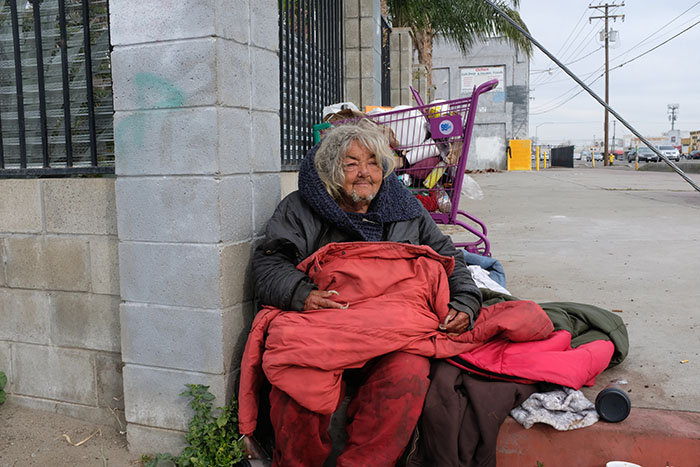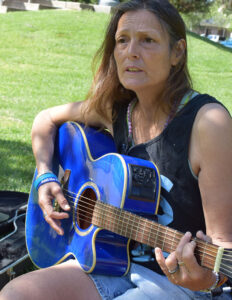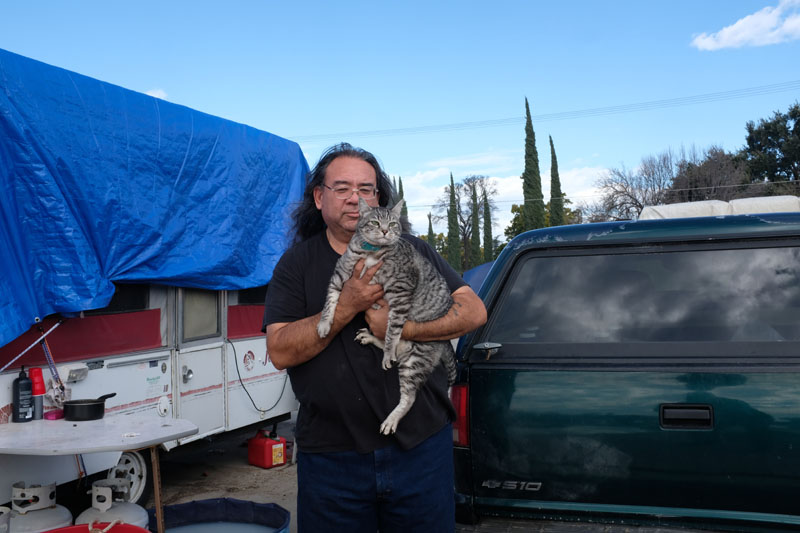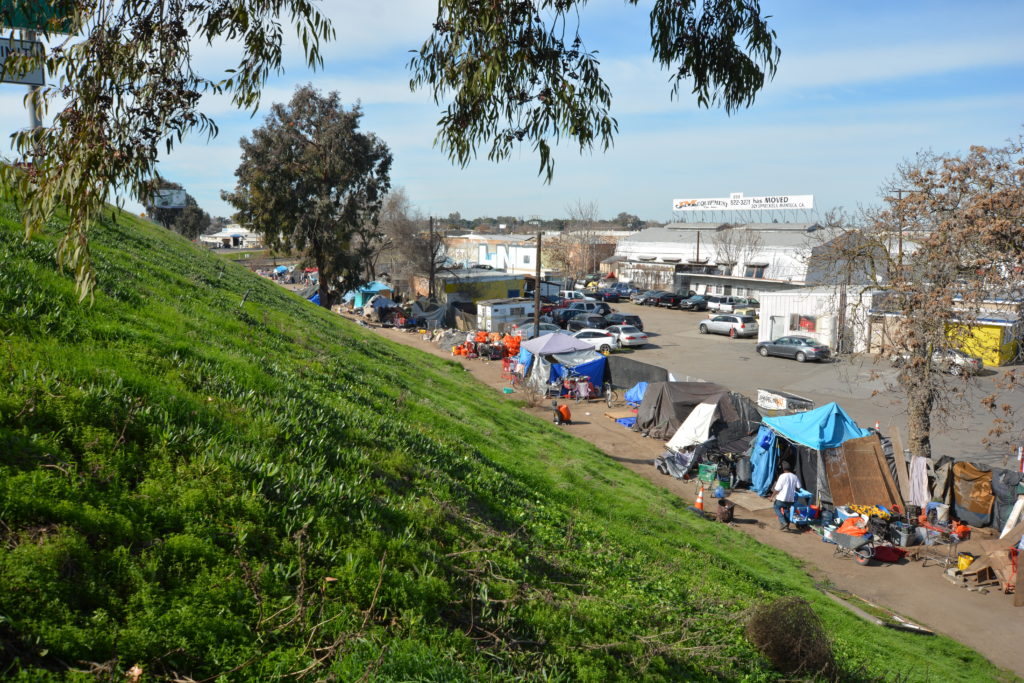
Consider the case of a 74 year old woman who stood, sat, and slept in plain sight on the concrete along a busy street just outside Modesto’s city limits for over six weeks, her pants soiled with her own waste, her fingernails and toenails grotesquely untended, and the space around her littered with trash and garbage. Consider also that she is almost certainly developmentally disabled, has an authorized payee, and earlier this year was living in a subsidized motel room.
Then consider the case of Mary Baca. We first wrote about Mary in October of 2015, when she showed up in a Modesto Park after several months living in her car. At the time, Mary showed clear signs of classic schizophrenia.
During her time on the streets — years now — Mary’s mental illness has gotten worse. An award-winning vocalist, , Mary can be seen singing and playing guitar on a video taped by Richard Anderson in May, 2016. At :28 seconds in, Mary talks about life in Modesto’s Graceada Park, and the seven homeless men responsible for home invasions in the Graceada neighborhood. Displaying textbook symptoms of schizophrenia, Mary discusses attempts by the seven underground men to control her mind.

Over the almost six years since she became homeless, Mary has received help from local authorities exactly once, when she spent 15 days at Doctor’s Behavioral Health Center, where she was prescribed medication and released back to the streets. Despite the best efforts of homeless friends, Mary stopped taking her medicine within a month of release. She reverted to severe schizophrenia almost immediately.
Last month, Mary was arrested on charges typically associated with homelessness, including, “Failing to leave property.” She’s currently in jail.
The 74-year-old woman?
After refusing numerous offers of help, she was taken off the street only when Modesto Police Sargent Mike Hammond went beyond the bounds of duty after hearing about her plight from outreach worker Randy Limburg of Telecare. Up until Hammond and his Homeless Engagement and Response (HEART ) team intervened, Limburg had been unable to get the woman to accept help. Today’s laws being what they are, Limburg was powerless even to help someone so obviously in need.
Though Hammond and his team have many years’ experience dealing with homeless people in crisis situations, it took extra measures of compassion, effort, and persuasion to get the woman into a better place, albeit still precariously short-term.
We cite these two cases as examples of inadequate systems of care, not because people lack compassion and the will to help, but because our laws so often prohibit intervention in clear cases of distress and our resources for addressing critical needs are far too limited. We could cite many, many more cases. Many of our readers could add to that number exponentially.
The point is that anyone who truly believes there are sufficient “services — including disability, mental health and drug and alcohol addiction resources” — for the hundreds upon hundreds of local homeless people who truly need them is either out of touch with reality or has never experienced the endless futility of dealing with our systems of care. Just ask Steven Finch.
Finch recently formed “SHARE,” the Stanislaus Homeless Advocacy and Resource Enterprise. Finch thought applying a successful model of individual sponsorship and assistance from other volunteer organizations would work with homelessness. He soon found that,
“Agencies and non-profits are so strained and understaffed they are at a breaking point,” They refer you back and forth and the referral is sometimes to a phone with no answer and a mailbox that is full. There are many good people in this work, but it seems their hands are tied.”
Finch also learned that a great deal of local budget money for homelessness,
“Gets burned up by short-term congregate living solutions. These are not a solution for many people, so they end up back on the streets. I spoke with the Director at Family Promise and she said they could ramp up their program to 4-5 times the size and pace, but at the end of the day, there is NO long-term housing for graduates of the program.”
Given these realities, the City of Turlock’s recent decision to spend half a million dollars on a 120-day project to reduce the effects of homelessness citywide is indefensible. Most of the money will go towards expanding the number of available beds in congregate living facilities. Assuming the beds fill — an optimistic projection at best — the chances a significant number of people will move from those beds to better situations than they’re currently experiencing are infinitesimal.

Theoretically, the beds will be needed to accommodate homeless people who’ve been forced to move from current locations, especially highly visible camps. Many of those people have been living in cars, campers, motor homes and trailers. Asking them to move into congregate living during a pandemic, especially in a county notorious for its failures to address Covid-19, is like asking the household cat to take up residence in the hot tub. Good luck.
Doubtful? Just ask anyone with a few years’ experience dealing with homelessness.
Sweeps of homeless people generally occur once or twice a year. The City of Modesto has recently engaged in yet another one. It includes a coordinated effort by the Modesto Police Department, Stanislaus County Sheriffs, and Caltrans. The results are visible to the naked eye. Homeless people, formerly camped under bridges, along railroad tracks and highways and in other out-of-the-way places are now stranded in local parks or sitting on curbsides downtown. They’re everywhere.
Despite repeated failures to reduce homelessness, sweeps remain the default strategy for authorities in Stanislaus County. Sometimes they’re accomplished with much fanfare, like the current sweep in Turlock. City and county officials release detailed plans about beds and services, in hopes the public will yet again fail to learn from experience.
But even the most gullible onlookers can’t ignore the evidence of their senses, and by every indicator, homeless numbers have risen every year. In fact, even when Turlock adds beds, there won’t be enough to accommodate current numbers of homeless people.

And that brings us to the recent decision by the 9th Circuit Court, which holds that homeless people sleeping on public property can’t be required to move or penalized if there are no other places available to lay their heads. Given that shelters throughout Stanislaus County have been at reduced capacity because of Covid-19, there has been no way to argue homeless people have alternatives to sleeping outside.
Nonetheless, authorities have persisted at chasing homeless people, claiming that, “We always have five or six places available.” The claim is so thin that even authorities accustomed to bullying people who can’t afford attorneys have gotten nervous about the prospect that a pro bono law firm might come along and expose their bluffs.
However, if cities and counties do manage to add beds, and if Covid does become manageable, then their argument about having enough beds becomes a little stronger — but only a little. The fact is, the 2020 Point in Time homeless count for Modesto registered over 1592 homeless people in the city alone, not including people outside the city limits. Most experienced observers agree it was a significant undercount of true numbers. Add all available beds together throughout the city, and the total is still far short of even a thousand, let alone more.
So in addition to accomplishing little to nothing in reducing homelessness, today’s sweeps leave local authorities legally vulnerable, especially since they have better options.

One such option, much favored by people on the ground, is to permit people living in cars, trailers and motor homes to park in designated areas. They could be approached on site by outreach workers and the costs of care and law enforcement would drop exponentially.
Another option is permitted camping. Modesto showed promising success with permitted camping when it approved of MOES (Modesto Outdoor Emergency Shelter), a tent encampment that sheltered homeless people at a cost of approximately $13 per day.
In addition to permitted campsites, cities throughout the west have recently begun establishing “bridge” communities featuring tiered housing options such as Pallet Shelters in cities like Fresno, Los Angeles, and Sonoma, Conestoga Huts in the northwest, and various kinds of sheds. The advantages of permitted camping and tiered housing options include reduced costs for law enforcement, easier access for social service providers and volunteers, and lowered costs of health care and emergency assistance for homeless people.
As for spending more money on beds in congregate living situations, the record is clear: It doesn’t work. The return on investment is illusory and ephemeral.
Citizens who want to see homeless numbers improve need to penalize repeated failures by public officials to act effectively, and reward efforts that reduce harm. The time-honored way to do so is via the ballot box.
If a program were able to regionalize 175,000 homeless citizens at 5 strategic locations across America in one fell swoop then the homeless would find safe refuge and a hand up not a hand out. We at Rehab City located in Whiteville, NC have strategized ever since we were formed. I began my homelessness in Modesto, CA and I walked across American for more than 2 years studying root causes, consistent inadequacy of services, hoping to find an answer. There are 600,000 homeless on any given night in these United States…emerging issues of 3rd and 4th generation children have never known what the comforts of a stable home, and may never. Statistics categorically prove rousting, or relocating homeless citizens from one encampment to another does nothing but frustrate any progress a homeless person may have begun, or attached themselves to. Most agencies will drop a client like a hot potato if the client’s zip code changes.
Email me @ [email protected] for further information.
Great article Eric. Your bottom-line speaks volumes to failed homelessness actions within our county. It does beg the question, why?
Let me hazard a guess: We’ve had/have elected officials who are entrenched in a belief system that has these characteristics:
– work is the only way to a decent and independent life.
– you and your family are solely responsible for your well being despite factors beyond your control including rises in the cost of living, stagnant wages, job loss due to globalization, automation, and artificial intelligence, higher costs of education, and diminished social resources
– If you’re not making it and you need help, it’s because you’re making bad decisions and now you must suffer the consequences. Sometimes you get a pass if you have a disability which is an acceptable disability, then you might get some outside help, else suffer.
In a word, I’d say this collection of beliefs lack empathy. Empathy may in fact be biological; thus, one may have no control of it’s expression.
So if empathy is key to a fair and just society then we must have decision makers in all elements of society who exhibit empathy in their decision making.
A definition of evil is, when one causes intentional suffering upon others! Empathetic people are the folks we must elect to represent us if we want to end the suffering homelessness people endure as well as an end to homelessness.
Frank, really ??
I’m not surprised by Eric’s article but you know how much this elected has done and how much progress we have made across the county, didn’t expect this from you,
Despite your best and laudable efforts, the problem still exists without any discernable improvement. What does that tell you? For certain, it tells you that it isn’t enough ,assuming it is the right thing to do. That brings us to the second tell, which is that maybe it isn’t the right thing to do. I think that is what the article is all about. In politics, as in life. you seldom get enough credit for what you do accomplish, but you never get credit for what you don’t.
Hi Terry. Sorry that it came across as directed at you as it wasn’t. I do know what you have done but one person can’t do all the heavy lifting needed. We need communities to do that along with assistance and leadership.
As you know I’ve been working as a volunteer with the disadvantaged for 25+ years now as well as involvement in all aspects of the system of care. Thus I speak from that experience where I see what works and what doesn’t. What works best is proving love and care and that’s my bottom-line and what I try to do with all the folks I encounter.
What country are you talking about? Certainly not the US under the previous administration.
Thanks Frank for your insightful perspectives on this crisis both inside & outside of our community. There are no simple & easy solutions but it seems like local communities are going to have to speak to it as our leaders seem to vacillate between ignoring homelessness and claiming that they deserve whatever suffering they endure as punishment for their own homelessness
Tx Debra. Haven’t heard from you in ages. Hope all is well with you. Still up yonder?
Well said Frank- As a former resident of MOES( Modesto Outdoor Emergency Shelter) I completely agree that empathy should be something an elected official should possess but we (the homeless) need so much more then just the empathy of another human being, we need action. I know there is a process to everything.. everything involving change takes 50 people to dote the I’m before its even on a ballet, we need zoning laws to change,so we can house on commercial property. We need law makers that don’t close the curtains when asked to about the homeless. But once again time and a thousand more are on the streets.
I don’t plan on closing the curtains. I will be that pain in the A, that will keep addressing the issues. You’re right elected leaders quickly forget about the homeless once in power. I have a plan that would utilize military bases that have been closed, like the one in Merced. I now hear they have commercial plans for, Adam Gray should hear me out and work with me to restore this for homeless housing, not commercial space. It is perfect for the program I have in mind.
I been on the streets for a few years besides the 7 months at salvation army shelter when i was promise a place at the Kansas house whitch never came through because they pick an choose who they want and i live by there rules every day did what they asked to not even get a chance . now where am i a single parent i went not even seeing my daughter because the shelter didnt allow kids on the property. So i left because i wanted to see an be with my child. Even when i lived at moes and i told them i had a little girl and they still wont put me in the family circle its like they blow me off.
Tremendous article, just wanted to say I’m relieved to find that journalistic integrity exists in the world still, let alone our own county. Very proud of you for speaking on behalf of those of us without voices that can be heard and for leading the way for this entire community towards a realistic solution by example.
This issue is endlessly complex and the obstacles are many and vast, but real positive change will only come with an honest assessment of those obstacles such as yours in this article. All citizens of every status can take a page out of your book, this is not a partizan issue…we clearly need more people like you who are brave enough to speak truth to power and question the status quo that has only made our struggle all the more painful thus far.
Thanks again.
Anyone can he homeless in a minute. We need to make a plan and fight for a shelter and be the voice some don’t have. We need not judge and make changes that are needed. I am willing to help wherever I can. A lot of people feel the same way..Let’s come together and be the change w.e need. The voice to hear and the heart to push through. #strongtogether#
We all hate seeing people on the streets, highways and laying around in parks. Modesto tax payouts paid out $5,000,000 fr the tents under the bridge. Modesto took this from them stating due to flooding. We all know it hasn’t flooded down there in over a number of years. Each of those tent houses tax payouts paid $5,000 each. Modesto has those tents somewhere not using them. But Modesto paid to have cemented paved paths under 7th and 9th street. Why I wouldn’t risk my life walking down there. Homeless are dirty the don’t pick up their trash leave trash behind. They don’t want to go to shelters because of their animals. That’s family to them. People driving by them and handing them money only pays for drugs or alcohol. I say give them back the tents give them back under the bridge. They where happy Modesto was happy. I hate driving to Modesto because of the homeless situation. I seen Turlock tent city out on the edge of town. Stop citing them it’s a waste of time and effort. They won’t go to court or pay the bills. Give them a spot hide them it’s what both sides want when it comes down to it. They get a check, food stamps even social security.
Abraham Maslow recognized that shelter is foundational to wholeness.
Excuses have been allowed to obstruct many of mankinds’ basic needs.
Perhaps too few of us are on a search for legitimate longterm means to treat others as we want to be treated.
.
Bad attitudes cause structural violence resulting in oppressions that there are zero excuses for.
May I suggest many of us pray for more empathy and forgiveness.
Thank you Mr. Valero. Very insightful.
I think I read (here?) that MOES was disbanded because it grew too large. We let it become a victim of its own success, which means it was meeting human needs. Why not resurrect MOES and find additional sites so it can expand to meet more needs? Cities were coming to us to find out how to handle the homeless in their communities.
The demonstration of the pallet shelters shows what can be done for relatively little cost while providing people shelter from the elements. Of course we need to provide bathrooms, laundry facilities and, after COVID-19, a common room where residents can receive services. We need to recognize that we pay the costs now to house the homeless, or we pay much more later in a dysfunctional community.
DEAR ERIC,
NOTICED WE HAVE NOT HEARD FROM YOU SINCE THE 20TH. WE LOOK FORWARD TO HEARING WHAT IS ON YOUR MIND AND IN YOUR HEART.
HOPE YOU DON’T TAKE THIS AS IMPATIENCE…BUT CONCERN FOR YOU.
PRAYING YOU ARE WELL
Comments are closed.